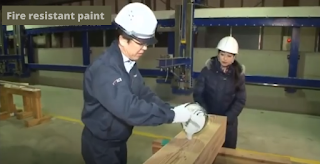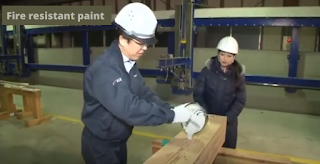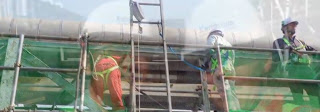When it comes to safeguarding steel structures from the
devastating effects of fire, choosing the right fireproofing paint can
make all the difference. Steel, while renowned for its strength and durability,
is susceptible to high temperatures, which can compromise its structural
integrity. Fortunately, various types of fireproofing paints are available to
provide an effective barrier against heat and flames, ensuring the safety of
occupants and the longevity of the building.
Intumescent Coatings
Intumescent coatings are a popular and highly effective
type of fireproofing paint for steel structures. These specialized coatings are
designed to swell and form a thick, insulating char layer when exposed to high
temperatures. This char layer acts as a barrier, shielding the steel from
direct heat exposure and slowing down the heat transfer process. Intumescent
coatings are available in various formulations, including solvent-based,
water-based, and epoxy-based variants, catering to different environmental
conditions and aesthetic requirements.
Cementitious Coatings
Cementitious coatings, also known as mineral-based
coatings, offer a robust and long-lasting fireproofing solution for steel
structures. These coatings are composed of mineral fibers, cements, and other
additives, forming a durable and heat-resistant layer around the steel members.
Cementitious coatings are particularly effective in providing long-term
protection against fire and can withstand harsh environmental conditions,
making them suitable for both indoor and outdoor applications.
Epoxy-Based Coatings
Epoxy-based coatings are another type of fireproofing paint
that provides excellent protection for steel structures. These coatings are
formulated with epoxy resins and various additives, creating a tough and
durable barrier against heat and flames. Epoxy-based coatings are known for
their superior adhesion to steel surfaces, ensuring long-lasting protection
even in demanding environments. Additionally, they offer resistance to
chemicals, abrasion, and moisture, making them suitable for a wide range of
applications.
Hybrid Coatings
Hybrid coatings are a combination of different fireproofing
technologies, such as intumescent and cementitious or epoxy-based components.
These coatings offer the advantages of multiple fireproofing systems, providing
enhanced protection and versatility. Hybrid coatings are designed to meet specific
performance requirements, such as resistance to extreme temperatures,
durability, and ease of application.
When selecting the appropriate fireproofing paint for your
steel structure, it's crucial to consider factors such as the intended use of
the building, the level of fire resistance required, environmental conditions,
and aesthetic considerations. Consulting with experienced professionals, such
as structural engineers and fire protection experts, can help you make an
informed decision and ensure compliance with relevant building codes and
regulations.
Proper surface preparation and application of the
fireproofing paint are equally important to ensure optimal performance and
longevity. Manufacturers typically provide detailed instructions and guidelines
for surface preparation, application methods, and recommended coating
thicknesses to achieve the desired fire resistance ratings.
Investing in high-quality fireproofing paint for steel structures is a critical step in ensuring the safety of occupants and protecting valuable assets. By selecting the appropriate type of fireproofing paint and following proper application procedures, you can safeguard your steel structure against the devastating effects of fire, contributing to a safer and more resilient built environment.
Also Read: Safeguarding Your Steel Structure: The Top 4 Effective Fireproofing Methods











